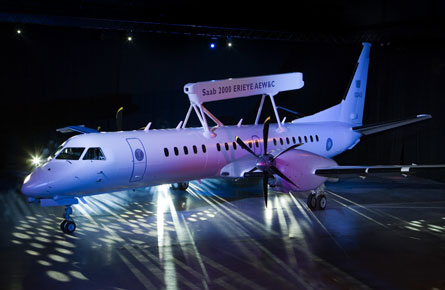Saab has identified 30 potential new customers for its Erieye airborne early warning and control system within the next 10 years, and is stepping up efforts to promote its new Saab 2000 configuration, which will make its first flight within weeks for the Pakistan air force.
"Every country that's interested in AEW is a possibility for us," says Saab Microwave Systems' Saab 2000 AEW&C project manager Joakim Andersson, who declines to name specific candidates. The company has also previously succeeded in selling Embraer EMB-145- and Saab 340-based Erieye systems to Brazil, Greece, Mexico, Sweden and Thailand, and "expects a hit rate of about 50%" from its new campaigns, says vice-president surveillance systems Lars Karlén.
Believed to be Pakistan's first of five Erieye systems, the Saab 2000-based surveillance aircraft is currently undergoing ground testing in Linköping, where Islamabad's second example is also now in teardown. This pre-modification refurbishment programme will deliver an aircraft "more or less as new", says Andersson.
 |
|---|
© Saab |
Pakistan's aircraft has five on-board operator stations, versus three on modified EMB-145s and Sweden's two upgraded Saab 340s, a service ceiling of over 30,000ft (9,150m) and a mission endurance approaching 10h. The type also features enhanced engines, new generators, additional cooling for on-board mission equipment and a Saab HES-21 electronic warfare suite comprising laser, radar and missile approach warners and countermeasures dispensers.
The aircraft's fuselage has been strengthened to carry the Erieye radar, while its vertical tail has been extended to compensate for the payload, which provides 150e_SDgr coverage to each side of its conformal array. The Saab 2000's outer wing has also been strengthened to accommodate EW and signals intelligence sensors, and for the possible carriage of a towed radar decoy.
Saab says the use of new-generation radar transmit/receive modules with 60% higher output have increased the AEW range of the Erieye design, which can also now detect hovering helicopters and track small naval targets to a range of 350km (190nm).
 |
|---|
© Saab |
The global fleet of Saab 2000s now totals 58 airframes. Around 20 of these are owned by the Swedish manufacturer's aircraft leasing unit, which says the type has a projected operating life of at least 75,000 flight hours. "We have sufficient aircraft for a lot of different customers," says Andersson, adding: "Given typical utilisation, they are due to operate for the next 35 to 40 years."
Source: Flight International



















